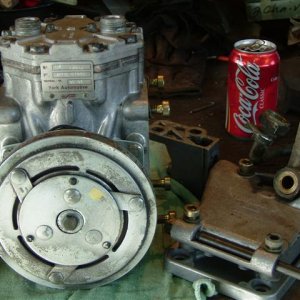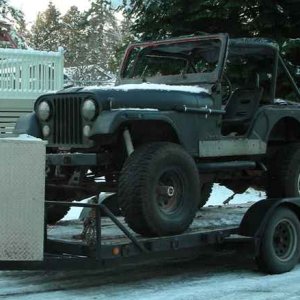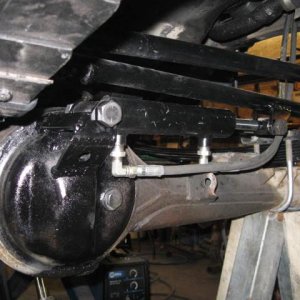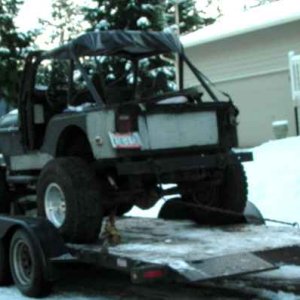You are using an out of date browser. It may not display this or other websites correctly.
You should upgrade or use an alternative browser.
You should upgrade or use an alternative browser.
Looking to get into a TIG machine
- Thread starter patooyee
- Start date
TBItoy
Well-Known Member
Re:
I started doing lots of TIG welding last year when I took a new job. I really like it also and prefer to TIG all the brackets and fixtures I can.
Funny/sucks, I smashed the tip of my left middle finger last year and fully understand what you mean about filler rod feeder feel....
I started doing lots of TIG welding last year when I took a new job. I really like it also and prefer to TIG all the brackets and fixtures I can.
Funny/sucks, I smashed the tip of my left middle finger last year and fully understand what you mean about filler rod feeder feel....
kmcminn
Well-Known Member
I used mine on a aluminum boat today. I still suck. But it doesn't leak.
patooyee
Well-Known Member
- Joined
- Sep 27, 2008
- Messages
- 5,692
I swung by the shop tonight on my way home just to give roll cage tubing a try with the little machine. This was 1.5 x .120 HREW with 3/32 filler, 1/16 thoriated, 100 amps, #5 cup with gas lens.

It was a bit too hot but the 3/32 filler rod was already sticking a little bit and when I went down to 80 amps it felt about right but then the rod was sticking really bad. I feel like I would have done a lot better with 1/16 filler dabbing more often but I don't have any at the moment. For the most part though I was pretty happy and everything was going good until the tip of the cup shot off with a loud pop.

I'm guessing it just got too hot / was too small? I think a #6 cup would have done better anyway but what causes that to happen? That was my only cup for that torch too so I guess I'm going shopping tomorrow.

It was a bit too hot but the 3/32 filler rod was already sticking a little bit and when I went down to 80 amps it felt about right but then the rod was sticking really bad. I feel like I would have done a lot better with 1/16 filler dabbing more often but I don't have any at the moment. For the most part though I was pretty happy and everything was going good until the tip of the cup shot off with a loud pop.

I'm guessing it just got too hot / was too small? I think a #6 cup would have done better anyway but what causes that to happen? That was my only cup for that torch too so I guess I'm going shopping tomorrow.
zjtrey
Well-Known Member
you definitely need to be running a bigger cup… most guys say run as big as you can fit in the area you're welding on… bigger cup will help with the oxidation on the toes of the weld and a shiner cleaner weld in general… you can't purge too much!
Radnor is putting out some really nice electrodes right now that are intended to replace the throreated stuff.. a guy recently turned me on to the e3 electrodes.. intended for both steel and aluminum.. extremely stable arc and heat dissipation which helps the tip stay sharp longer on aluminum.. I found them really helpful..
Radnor is putting out some really nice electrodes right now that are intended to replace the throreated stuff.. a guy recently turned me on to the e3 electrodes.. intended for both steel and aluminum.. extremely stable arc and heat dissipation which helps the tip stay sharp longer on aluminum.. I found them really helpful..
patooyee
Well-Known Member
- Joined
- Sep 27, 2008
- Messages
- 5,692
So yesterday I was welding up an aluminum luggage rack for the back of my buggy using 1x1 square tube. I was really excited about how it all just clicked with me the other day and I was eager to get back at it. It was going really good 99% of the project, I was stacking dimes like a champ. But toward the end on two of the seams I was welding there was one pinhole on each that ABSO****INGLUTELY would not weld. I couldn't get the flame to center of the hole, it would jump all around it. If I moved the torch over it the arc would wander sideways to the side. Filler would not go in it either. Even if I finagled a drop to fall in via gravity it would jump right out instantly. Heating all around it would cause filler to fuse around it but it would never go in that hole. I could dab on one side and move the heat to the other and the puddle would flow with the torch but pull filler AROUND the hole, not into it. Despite using new aluminum and having cleaned it with the wire brush I figured there must have been some sort of contaminant. So I busted out a flap disc that I only use for aluminum and grinded it all out back down to bare tube, tried again, same spots wouldn't weld. So then I grinded a hole in the mother ****er. I figured there wouldn't be contaminants if there wasn't material to contaminate. Welded the holes closed just fine but then right when I got to where the old holes were new holes formed with the same results as above.
Its just a luggage rack and the holes are pinholes. In the grand scheme of things they matter not so I just left them. But I'm still ****ing PO'ed as to what was going on. I used about 30' of filler rod on this whole piece. There were about 75 or so 1" seams that welded perfectly and then these 2 that did for all but 2 pinholes worth. Anyone got any clue what was going on here? I sure would have been pissed off even worse had I been doing a fuel cell with perfect leak-free seams all the way to the last 2 inches and then have this **** happen.
Its just a luggage rack and the holes are pinholes. In the grand scheme of things they matter not so I just left them. But I'm still ****ing PO'ed as to what was going on. I used about 30' of filler rod on this whole piece. There were about 75 or so 1" seams that welded perfectly and then these 2 that did for all but 2 pinholes worth. Anyone got any clue what was going on here? I sure would have been pissed off even worse had I been doing a fuel cell with perfect leak-free seams all the way to the last 2 inches and then have this **** happen.
sleepsontoilet
Well-Known Member
I like the looks of that cheaper tig you picked up. What's the thickest it's rated to weld? Looks like a nice welder for a hobbyist to learn on.
patooyee
Well-Known Member
- Joined
- Sep 27, 2008
- Messages
- 5,692
sleepsontoilet said:I like the looks of that cheaper tig you picked up. What's the thickest it's rated to weld? Looks like a nice welder for a hobbyist to learn on.
It's a DC-only unit, so no aluminum. I'm not sure what its max rated steel thickness is but most machines will generally do thicker than rated. Its max amps is 160 on 220-volts. The general rule of thumb is 1 amp per .001" thickness so that means .160 would be about its max "on paper." But I would feel plenty safe doing .25" in a single pass with it at 160 amps and of course much thicker with multiple passes and / or preheating. Like I said, at 100 amps it was able to fairly easily melt right through that .120 wall when according to the 1-amp/.001" rule I should have been at 120 amps. I like that little machine though. It holds a nice tight arc with everything I've done so far. I'm going to get a flex-head torch for it and start using it for all my roll-cage welding.
Edit: I've had the same experience on .120 tube at 100 amps using my Synchrowave so I don't think its just the little machine running hot. I think the 1-amp/.001" rule is just a general guideline. I've found it to result in being too hot on just about everything I've tried so far in fact. Its more accurate the thinner you go, IMHO. For instance, I found that 50-60 amps was about perfect for some .060" aluminum I was doing for that switch panel.
mna0121
Well-Known Member
JJ, are the tubes you are welding closed off on the ends, could captured heat be causing the slag to blow away or implode?
patooyee
Well-Known Member
- Joined
- Sep 27, 2008
- Messages
- 5,692
mna0121 said:JJ, are the tubes you are welding closed off on the ends, could captured heat be causing the slag to blow away or implode?
They are and I thought about that. But in total there were 13 closed tubes that I welded and only 2 of them did that. Plus, when I grinded the hole to start over I was able to get a good air-tight base underneath where the holes were. It was only once I was going back over that base to basically add material to get back to the original square shape that the pinhole formed again. So in other words, the pinhole didn't go all the way through to the inside of the tube.
You can't weld a tube completely closed without drilling a hole for the gases to escape.We learned this by trying to use a roll cage for an air tank in a drag car one time. Couldn't get it to seal off no matter what we did until we went ahead and drilled the hole for the fitting.If you start really looking at welds you can usually see a spot that doesn't look just right.
Toddy
Well-Known Member
Alum is very hard to get the last seam to close up without blowing a hole. Drill a hole in it some where out of the way.
Also you can weld alum with DC. Helium gas and burn it in. Our welder at work will DC heavier stuff like 1/2 plate on DC. DC digs a lot better then AC on heavy stuff. Or pre heat and use AC but easier to flip the switch and DC it.
Also you can weld alum with DC. Helium gas and burn it in. Our welder at work will DC heavier stuff like 1/2 plate on DC. DC digs a lot better then AC on heavy stuff. Or pre heat and use AC but easier to flip the switch and DC it.
yankster
Well-Known Member
If you let the tubes cool to ambient you can weld the holes right up before they get a chance to build pressure from heat expansion. The same principle as drilling a hole and welding it up later.
patooyee
Well-Known Member
- Joined
- Sep 27, 2008
- Messages
- 5,692
Can someone please help me understand my machine's ac balance control? Here's what the instructions say:

The previous owners scratched the S and A into the panel which I assume means steel and aluminum. I've indicated where these are on the panel by the red letters.
My understanding of ac balance is that you want more cleaning / electrode negative for aluminum to break the oxide layer away which the instructions seem to coincide with. The previous owner seems to think the opposite judging by their placement of the A scratch mark though.
I can get satisfactory welds on aluminum with the dial pretty much anywhere. I can definitely tell how more towards 10 I need less amperage and more towards 0 I need more. But at 2 or lower my electrode balls up like crazy and the arc isn't crisp at all. I can tell above 2 I'm not getting much cleaning action by looking at the clean zone around the beads. So where should I be for aluminum?
Also, I was taught to think of ac control as a percentage. Balanced would be 50%, 65% would be more E-, 35% more E+. But where does that put my dial? 2 I imagine would be about 50% which gives me a lot of penetration range and little cleaning range.
The previous owners scratched the S and A into the panel which I assume means steel and aluminum. I've indicated where these are on the panel by the red letters.
My understanding of ac balance is that you want more cleaning / electrode negative for aluminum to break the oxide layer away which the instructions seem to coincide with. The previous owner seems to think the opposite judging by their placement of the A scratch mark though.
I can get satisfactory welds on aluminum with the dial pretty much anywhere. I can definitely tell how more towards 10 I need less amperage and more towards 0 I need more. But at 2 or lower my electrode balls up like crazy and the arc isn't crisp at all. I can tell above 2 I'm not getting much cleaning action by looking at the clean zone around the beads. So where should I be for aluminum?
Also, I was taught to think of ac control as a percentage. Balanced would be 50%, 65% would be more E-, 35% more E+. But where does that put my dial? 2 I imagine would be about 50% which gives me a lot of penetration range and little cleaning range.
patooyee
Well-Known Member
- Joined
- Sep 27, 2008
- Messages
- 5,692
Playing with it more I'm definitely getting little to no cleaning action above 2. 2 and below I can get anywhere from a little to a lot depending on how much ball I'm willing to let the T do. Definitely getting a smaller ball with thoriated. So now I'm thinking the previous owner was smoking crack? But that sure doesn't use much of the dial since steel would be on 2, aluminum would be down to 0, and 3-10 would not be used???
Re:
http://www.thefabricator.com/article/aluminumwelding/preparing-for-aluminum-gtaw
Check this out it should help you understand it better. Because it sounds to me like your polarity is backwards.
Sent from my SM-N900V using Tapatalk
http://www.thefabricator.com/article/aluminumwelding/preparing-for-aluminum-gtaw
Check this out it should help you understand it better. Because it sounds to me like your polarity is backwards.
Sent from my SM-N900V using Tapatalk
patooyee
Well-Known Member
- Joined
- Sep 27, 2008
- Messages
- 5,692
Re:
I read it but I don't see why you think my polarity is backwards. I'm getting good welds, just trying to understand my ac balance setting is all.
gtmcgeejr said:http://www.thefabricator.com/article/aluminumwelding/preparing-for-aluminum-gtaw
Check this out it should help you understand it better. Because it sounds to me like your polarity is backwards.
Sent from my SM-N900V using Tapatalk
I read it but I don't see why you think my polarity is backwards. I'm getting good welds, just trying to understand my ac balance setting is all.
wont work
Well-Known Member
- Joined
- Apr 5, 2010
- Messages
- 1,265
I could type for hrs about that to do and us go back and forth on what works on what and what don't. Then you got good material vs old and so on.
I tell my students to watch this guy when they go home to pick up some extra tips when they just need that little extra to be a better welder.
good to watch and shows you things you cant read about in a book.
http://www.weldingtipsandtricks.com/
http://www.weldingtipsandtricks.com/aluminum-welding.html
I tell my students to watch this guy when they go home to pick up some extra tips when they just need that little extra to be a better welder.
good to watch and shows you things you cant read about in a book.
http://www.weldingtipsandtricks.com/
http://www.weldingtipsandtricks.com/aluminum-welding.html










